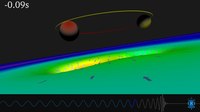
Photo from wikipedia
The stellar-to-halo mass relation (SHMR) is not only one of the main sources of information we have on the connection between galaxies and their dark matter haloes, but also an… Click to show full abstract
The stellar-to-halo mass relation (SHMR) is not only one of the main sources of information we have on the connection between galaxies and their dark matter haloes, but also an important indicator of the performance of galaxy formation models. Here we use one of the largest sample of galaxies with both high-quality rotation curves and near-infrared surface photometry, and perform a detailed comparative analysis of the SHMR. Our analysis shows that there are significant statistical differences between popular forms of the SHMR, and illustrates the predictive power of a new physically motivated scaling relation, which connects the stellar mass fraction ($M_{\star}/M_{\mathrm{h}}$) to the stellar specific angular momentum ($j_{\star}$) and the stellar radial velocity dispersion ($\sigma_{\star}$) via disc gravitational instability. Making use of such a relation, we demonstrate (i) how challenging it is to reproduce the efficiency of galaxy formation even for state-of-the-art cosmological hydrodynamical simulations, and (ii) that the evolution of the stellar mass fraction is regulated by disc gravitational instability: when $M_{\star}/M_{\mathrm{h}}$ varies, $j_{\star}$ and $\sigma_{\star}$ also vary as predicted by our scaling relation, thus erasing the memory of such evolution. This implies that the process of disc gravitational instability is intriguingly uniform across disc galaxies of all morphological types: from lenticulars to blue compact dwarfs. In particular, the cosmic variance of Toomre's $Q$ is 0.2 dex, a universal value for both stars and atomic gas.
Journal Title: Monthly Notices of the Royal Astronomical Society
Year Published: 2020
Link to full text (if available)
Share on Social Media: Sign Up to like & get
recommendations!